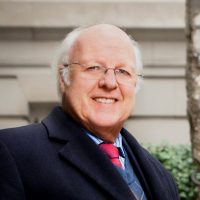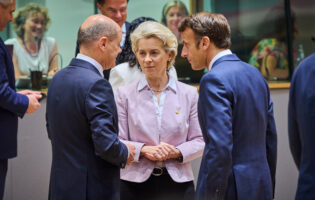Maximalist, Stephen Sestanovich

Jackson Janes
President Emeritus of AGI
Jackson Janes is the President Emeritus of the American-German Institute at the Johns Hopkins University in Washington, DC, where he has been affiliated since 1989.
Dr. Janes has been engaged in German-American affairs in numerous capacities over many years. He has studied and taught in German universities in Freiburg, Giessen and Tübingen. He was the Director of the German-American Institute in Tübingen (1977-1980) and then directed the European office of The German Marshall Fund of the United States in Bonn (1980-1985). Before joining AICGS, he served as Director of Program Development at the University Center for International Studies at the University of Pittsburgh (1986-1988). He was also Chair of the German Speaking Areas in Europe Program at the Foreign Service Institute in Washington, DC, from 1999-2000 and is Honorary President of the International Association for the Study of German Politics .
Dr. Janes is a member of the Council on Foreign Relations, the International Institute for Strategic Studies, the Atlantic Council of the United States, and American Purpose. He serves on the advisory boards of the Berlin office of the American Jewish Committee, and the Beirat der Zeitschrift für Außen- und Sicherheitspolitik (ZfAS). He serves on the Selection Committee for the Bundeskanzler Fellowships for the Alexander von Humboldt Foundation.
Dr. Janes has lectured throughout Europe and the United States and has published extensively on issues dealing with Germany, German-American relations, and transatlantic affairs. In addition to regular commentary given to European and American news radio, he has appeared on CBS, CNN, C-SPAN, PBS, CBC, and is a frequent commentator on German television. Dr. Janes is listed in Who’s Who in America and Who’s Who in Education.
In 2005, Dr. Janes was awarded the Officer’s Cross of the Order of Merit of the Federal Republic of Germany, Germany’s highest civilian award.
Education:
Ph.D., International Relations, Claremont Graduate School, Claremont, California
M.A., Divinity School, University of Chicago
B.A., Sociology, Colgate University
Expertise:
Transatlantic relations, German-American relations, domestic German politics, German-EU relations, transatlantic affairs.
__
Amid all the heated debates about the role of the United States in the current global morass of crises, the battle lines in America might fall between those who call for more limited engagement as the global sheriff versus those who advocate a more forceful presence on the world stage. The demonstration cases are multiple: Syria, Libya, Ukraine, not to speak of the Israel-Palestine conflict, or the fires flaring on the African continent.
According to Stephen Sestanovich in his new book, Maximalist: America in the World from Truman to Obama (Knopf, 2014), the cycles of American foreign policy run between those who advocate a maximalist, full engagement policy and those who argue for retrenchment, a more careful approach to involvement in other countries’ affairs. The cycles of approaches has been a constant in American foreign policy, often one following the other in different administrations and environments, each arguing that the lessons of the past support their views.
Sestanovich looks at the experiences of all the post-1945 U.S. presidents in their struggles to find their position in this continuing cycle. His conclusions are that most presidents might start on one path, and end on another. One might begin his administration with a robust foreign policy only to see a high price paid on the investment, with his successor demanding a more limited role. Or the reverse pattern might occur with a president demanding at his start a less aggressive policy but then finding himself confronted with events that demand engagement.
The fact is that the United States has both benefited from and been disadvantaged by the maximalist policies of some administrations as well as by the more minimalist approaches of others. We have experienced presidents who have taken up a huge challenge—Truman in the postwar period trying to mobilize the war-weary country for a another round of engagement in the emerging Cold War, or Kennedy proclaiming, “We will bear any burdens.” We also saw other presidents overplay their hands—Johnson in Vietnam, Bush in Iraq. We saw others try to rein in U.S. foreign policy engagements—Eisenhower after the Korean conflict or Obama after Bush’s legacy in Iraq and Afghanistan.
Sestanovich argues that while the U.S. has remained the dominant global power in this entire period, the uncertainty and indeed confusion about how U.S. power and influence might best be steered plagued all the administrations. Even in those cases in which U.S. interests were not objectively threatened, there was often a decision made to act to preserve American leadership or primacy on the world stage. That decision was often driven by the belief that there was no one else to exercise leadership whether it be in Europe, Asia, or South America. That did not prevent us from occasionally antagonizing friends or engendering fear among allies and foes.
And yet for both domestic political reasons as well as a widespread conviction among American leadership that the United States had an obligation to fix problems and stare down threats, American foreign policy led to a continuity of expanded engagement around the globe—for better in many cases and, sometimes, for worse.
The book looks back at the individuals in the White House who led the debates with each president, but it also recalls the domestic frameworks in which decisions were crafted. It ends with a focus on the current occupant of the White House, offering a few insights as to how lessons of past policies might be used today. Sestanovich suggests that Obama heard echoes of Eisenhower in the efforts to control the obligations of foreign policy while retaining the ability to act and react as needed with the most effective tools available. George H.W. Bush once called that dilemma “having more will than wallet.” Others refer to having to adjust aspirations to match abilities.
One red line visible in this book—but not expanded on—is the implications for U.S. allies in this continuing transition of U.S. policy positions. What can America expect from its friends in burden-sharing in the coming years? Who can take on what burdens—and who is willing? That is a particular challenge for Europe today. But that challenge is not new. What is new is the fact that the United States’ ability to shoulder responsibilities is becoming more constrained. U.S. power and influence remains—but its use and impact is changing.
The answers to those two questions are now more pressing than ever.








